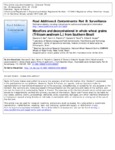Please use this identifier to cite or link to this item:
http://www.alice.cnptia.embrapa.br/alice/handle/doc/1007950| Title: | Mycoflora and deoxynivalenol in whole wheat grains (Triticum aestivum L.) from Southern Brazil. |
| Authors: | SAVI, G. D.  KARIM C. PIACENTINI   TIBOLA, C. S.   SCUSSEL, V. M.   |
| Affiliation: | GEOVANA D. SAVI, UFSC; KARIM C. PIACENTINI, UFSC; CASIANE SALETE TIBOLA, CNPT; VILDES M. SCUSSEL, UFSC. |
| Date Issued: | 2014 |
| Citation: | Food Additives & Contaminants: Part B: Surveillance, v. 7, n. 3, 232-237, Sept. 2014. |
| Description: | Fungi species Fusarium graminearum is related to deoxynivalenol (DON) formation. The aim of this study was to evaluate mycoflora and DON occurrence in 53 whole wheat grains samples collected in Southern Brazil during the 2012 crop. Wheat grains showed adequate values of water activity ranging from 0.48-0.72, within the required limits of moisture content, ranging from 9.1-13.9%. In addition low counts for fungal colonies, ranging from 10 to 8.2x102 were found. For Fusarium genera there was predominance of F. verticillioides (34%) and F. graminearum (30.2%). For Aspergillus species, 37.7% A. flavus was determined. Regarding the Penicillium species, P. digitatum (49%) was the most found species. DON was detected in 47.2% (25 out of 53) of the samples analyzed, with levels from 243.7 to 2281.3 ?g kg-1 (mean: 641.9 ?g kg-1). |
| Thesagro: | Aditivo Alimentação Contaminação Fusarium Graminearum Micotoxina Trigo |
| ISSN: | 1939-3210 |
| DOI: | 10.1080/19393210.2014.898337 |
| Type of Material: | Artigo de periódico |
| Access: | openAccess |
| Appears in Collections: | Artigo em periódico indexado (CNPT)  |
Files in This Item:
| File | Description | Size | Format | |
|---|---|---|---|---|
| 2014FoodAdditivesContaminantsBv7n3p232.pdf | 170.15 kB | Adobe PDF |  View/Open |









